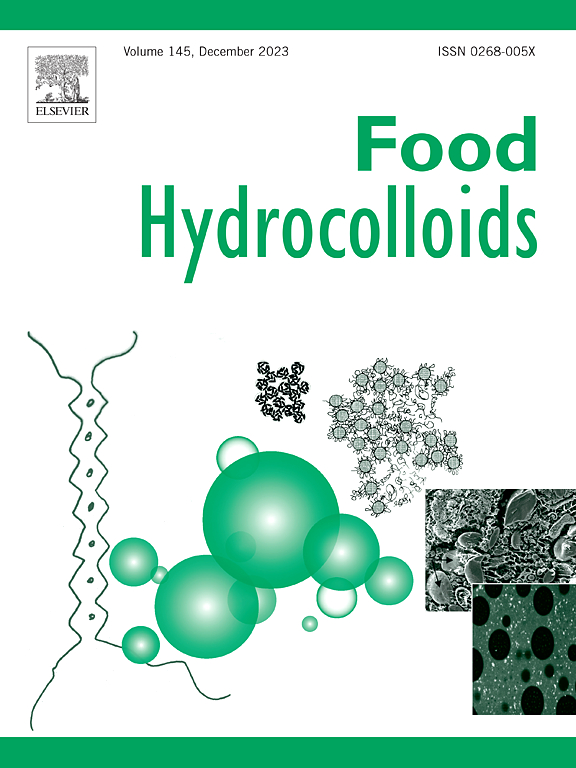不同7S/11S球蛋白比大豆分离蛋白高水分挤出物的质地和结构
IF 11
1区 农林科学
Q1 CHEMISTRY, APPLIED
引用次数: 0
摘要
采用时间多尺度方法研究了不同7S/11S比大豆分离蛋白(SPI)对植物纹理蛋白(TVP)结构的影响及其形成机制,以了解挤压过程中纤维结构的形成。虽然不同7S/11S比例对SPI二级结构的影响较小,但分离蛋白的持水性和乳化性能差异显著。高水分挤压实验结果表明,7S/11S比越高,TVP的硬度、弹性和咀嚼性显著提高,组织度提高14.28%。相关分析表明,高7S/11S比的蛋白具有较高的持水和乳化稳定性,主要原因是SPI的持水性能得到改善,在挤压过程中形成更多的二硫键,提高了TVP的硬度、弹性和咀嚼性。织构形成过程分析表明,材料在模区受到挤压,β-片含量增加,形成分子间二硫键和蛋白质聚集体。材料在成型区域受到垂直挤压方向的作用力,使紧密聚集的蛋白质分散,蛋白质进一步聚集交联,形成纤维结构。对不同7S/11S比的SPI形成TVP的研究为制备适合高水分结构蛋白加工的SPI提供了支持。本文章由计算机程序翻译,如有差异,请以英文原文为准。

Texture and structure of high-moisture extrudates produced from soybean protein isolates with different 7S/11S globulin ratios
The effects of different 7S/11S ratios of soybean isolate proteins (SPI) on the structure of textured vegetable proteins (TVP) and their formation mechanisms were investigated using a temporal multi-scale approach to understand the formation of fibrous structures throughout the extrusion process. Although the effect of different 7S/11S ratios on the secondary structure of the SPI was less, the water-holding and emulsification properties of the isolated proteins differed significantly. The results of the high-moisture extrusion experiments showed that the hardness, elasticity, and chewiness of TVP increased significantly with higher 7S/11S ratio and that the degree of organization improved by 14.28 %. Correlation analysis showed that proteins with high 7S/11S ratios had higher water-holding and emulsification stability mainly because of improvement in the water-holding property of the SPI, forming more disulfide bonds during extrusion, increasing the hardness, elasticity, and chewiness of TVP. Analysis of the texture formation process showed that the material underwent extrusion in the die zone, where the β-sheet content increased and inter-molecular disulfide bonds and protein aggregates were formed. The material was subjected to a force in the vertical extrusion direction in the molding area, which caused closely aggregated proteins to disperse, which further aggregated and cross-linked, resulting in the formation of fiber structure. Investigations on the formation of TVP from SPI with different 7S/11S ratios provided support for the preparation of suitable SPI for use in high-moisture textured protein processing.
求助全文
通过发布文献求助,成功后即可免费获取论文全文。
去求助
来源期刊

Food Hydrocolloids
工程技术-食品科技
CiteScore
19.90
自引率
14.00%
发文量
871
审稿时长
37 days
期刊介绍:
Food Hydrocolloids publishes original and innovative research focused on the characterization, functional properties, and applications of hydrocolloid materials used in food products. These hydrocolloids, defined as polysaccharides and proteins of commercial importance, are added to control aspects such as texture, stability, rheology, and sensory properties. The research's primary emphasis should be on the hydrocolloids themselves, with thorough descriptions of their source, nature, and physicochemical characteristics. Manuscripts are expected to clearly outline specific aims and objectives, include a fundamental discussion of research findings at the molecular level, and address the significance of the results. Studies on hydrocolloids in complex formulations should concentrate on their overall properties and mechanisms of action, while simple formulation development studies may not be considered for publication.
The main areas of interest are:
-Chemical and physicochemical characterisation
Thermal properties including glass transitions and conformational changes-
Rheological properties including viscosity, viscoelastic properties and gelation behaviour-
The influence on organoleptic properties-
Interfacial properties including stabilisation of dispersions, emulsions and foams-
Film forming properties with application to edible films and active packaging-
Encapsulation and controlled release of active compounds-
The influence on health including their role as dietary fibre-
Manipulation of hydrocolloid structure and functionality through chemical, biochemical and physical processes-
New hydrocolloids and hydrocolloid sources of commercial potential.
The Journal also publishes Review articles that provide an overview of the latest developments in topics of specific interest to researchers in this field of activity.
 求助内容:
求助内容: 应助结果提醒方式:
应助结果提醒方式:


